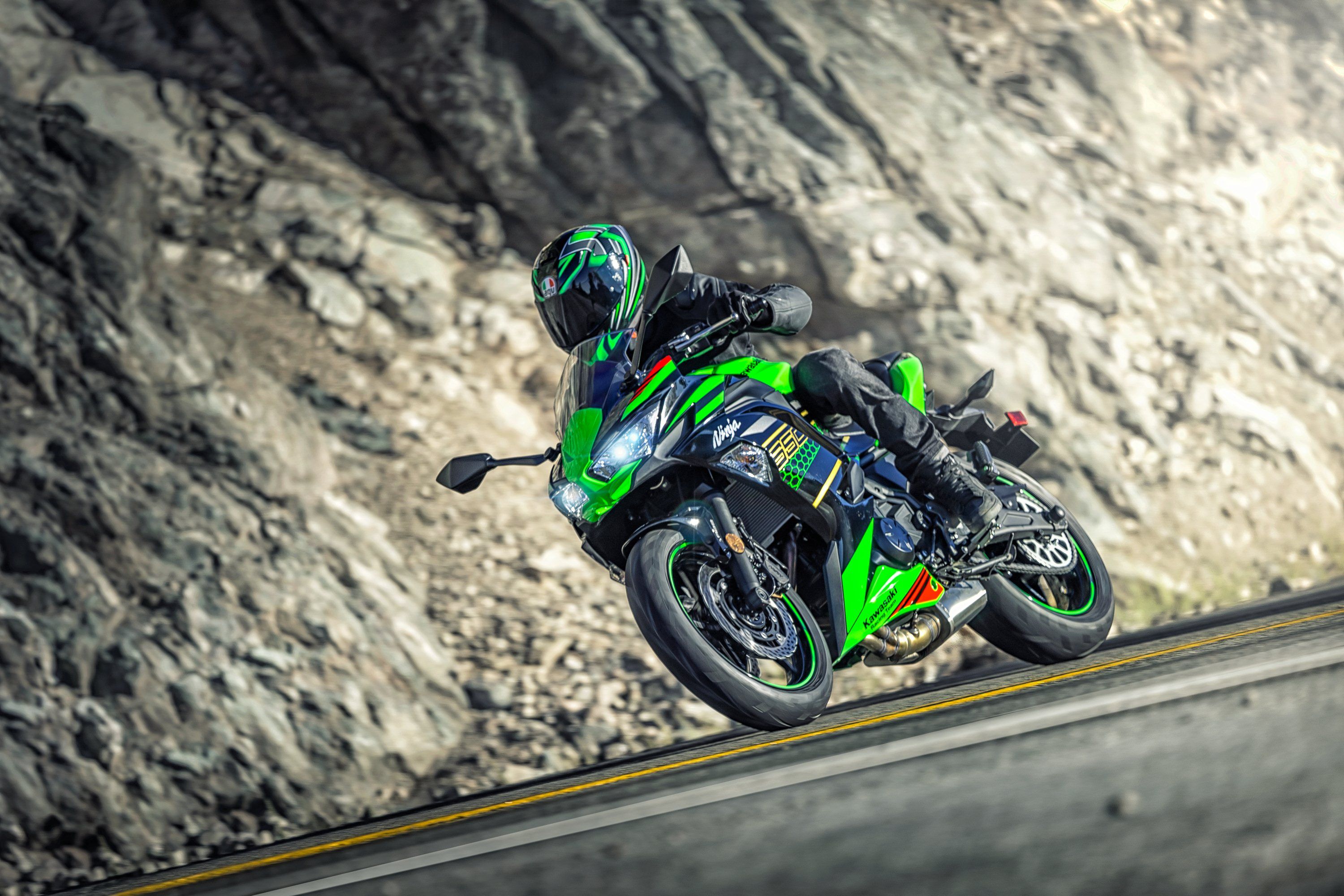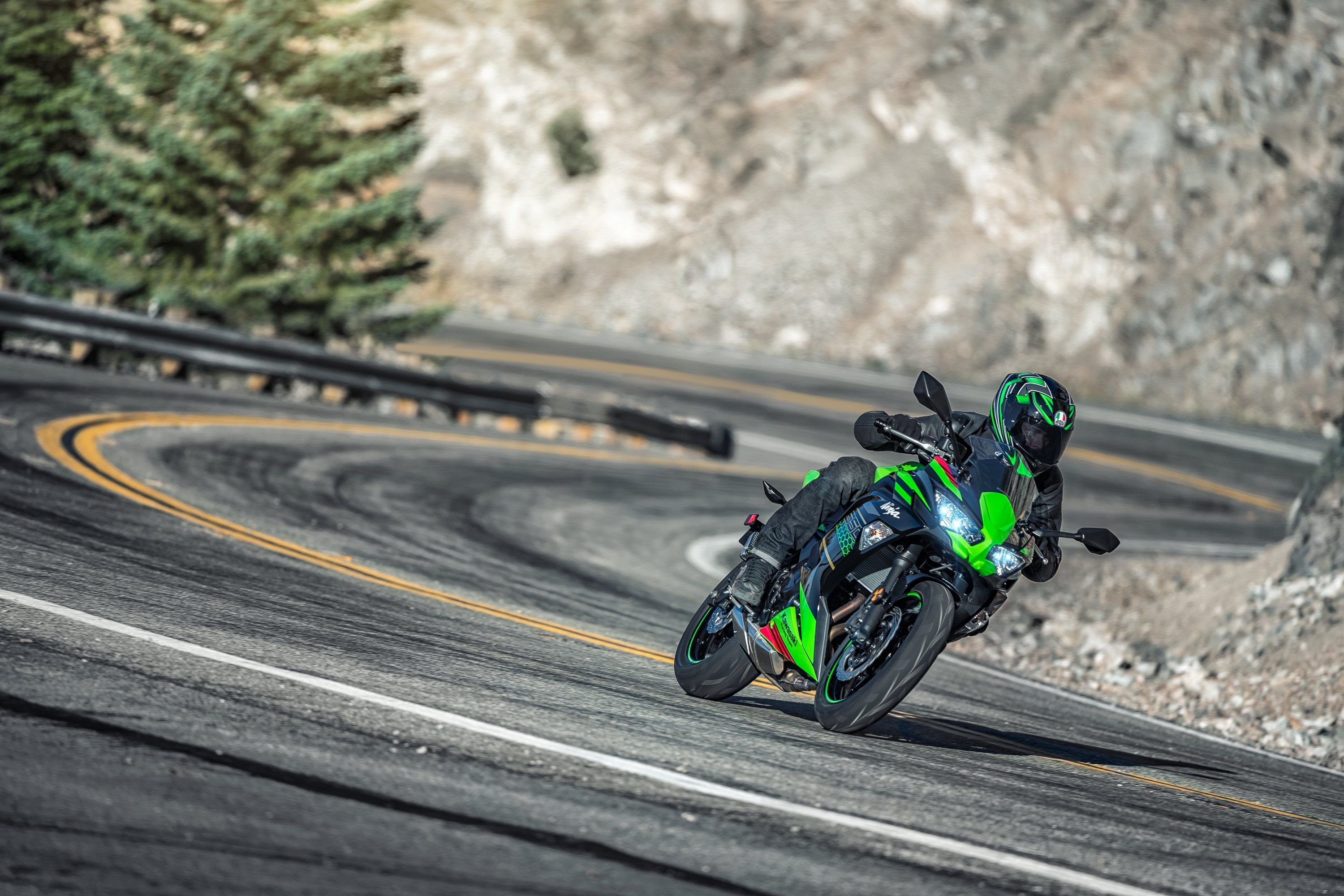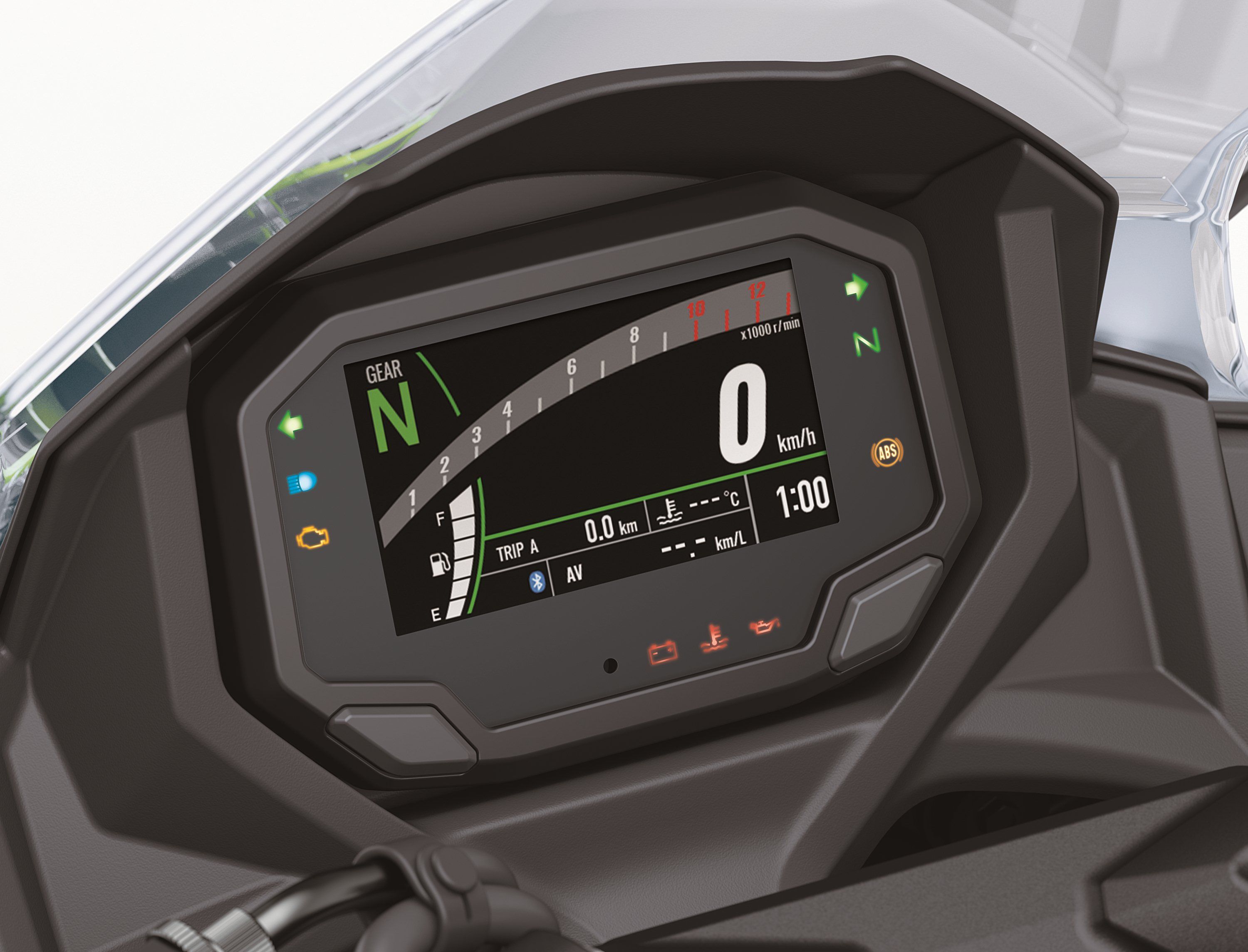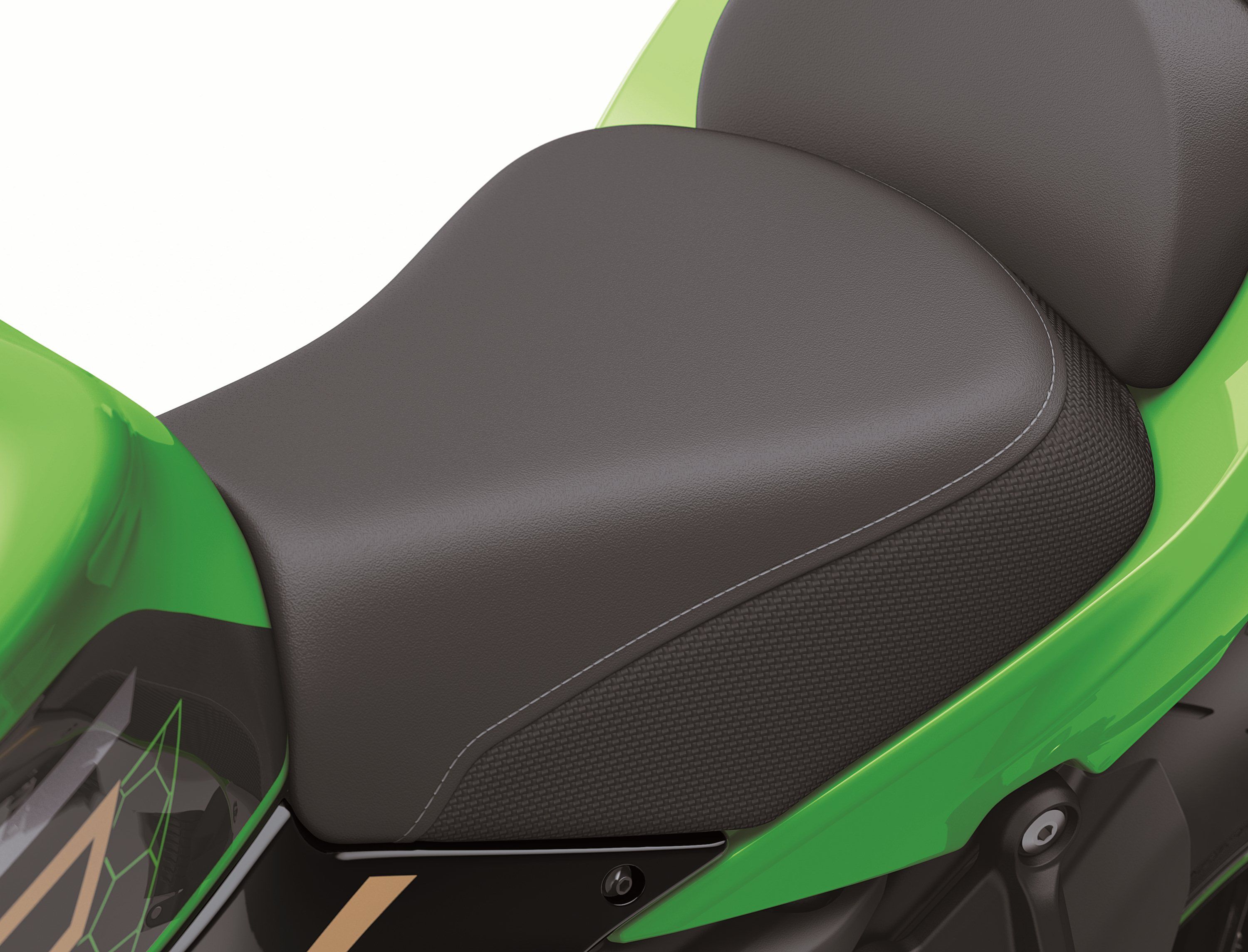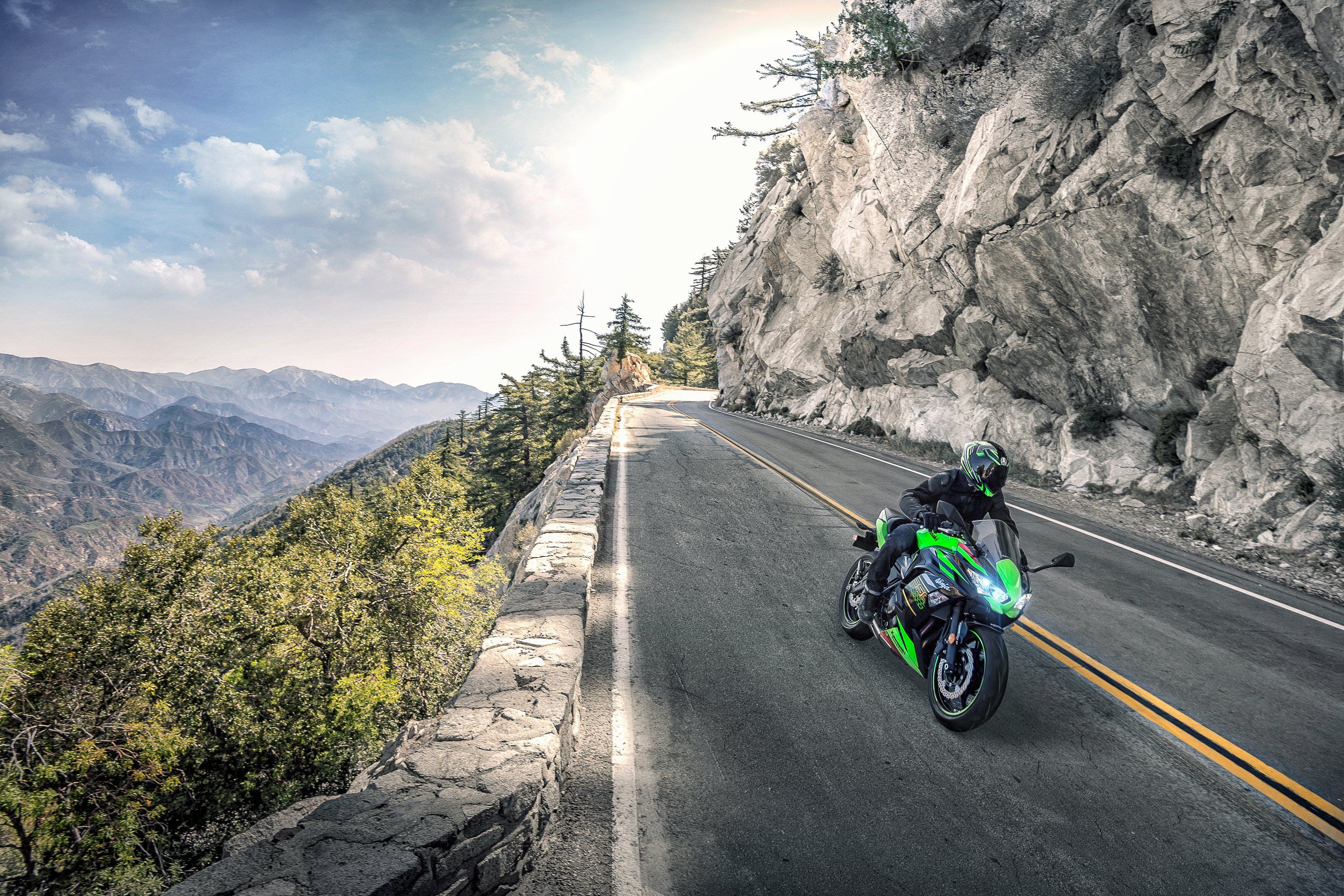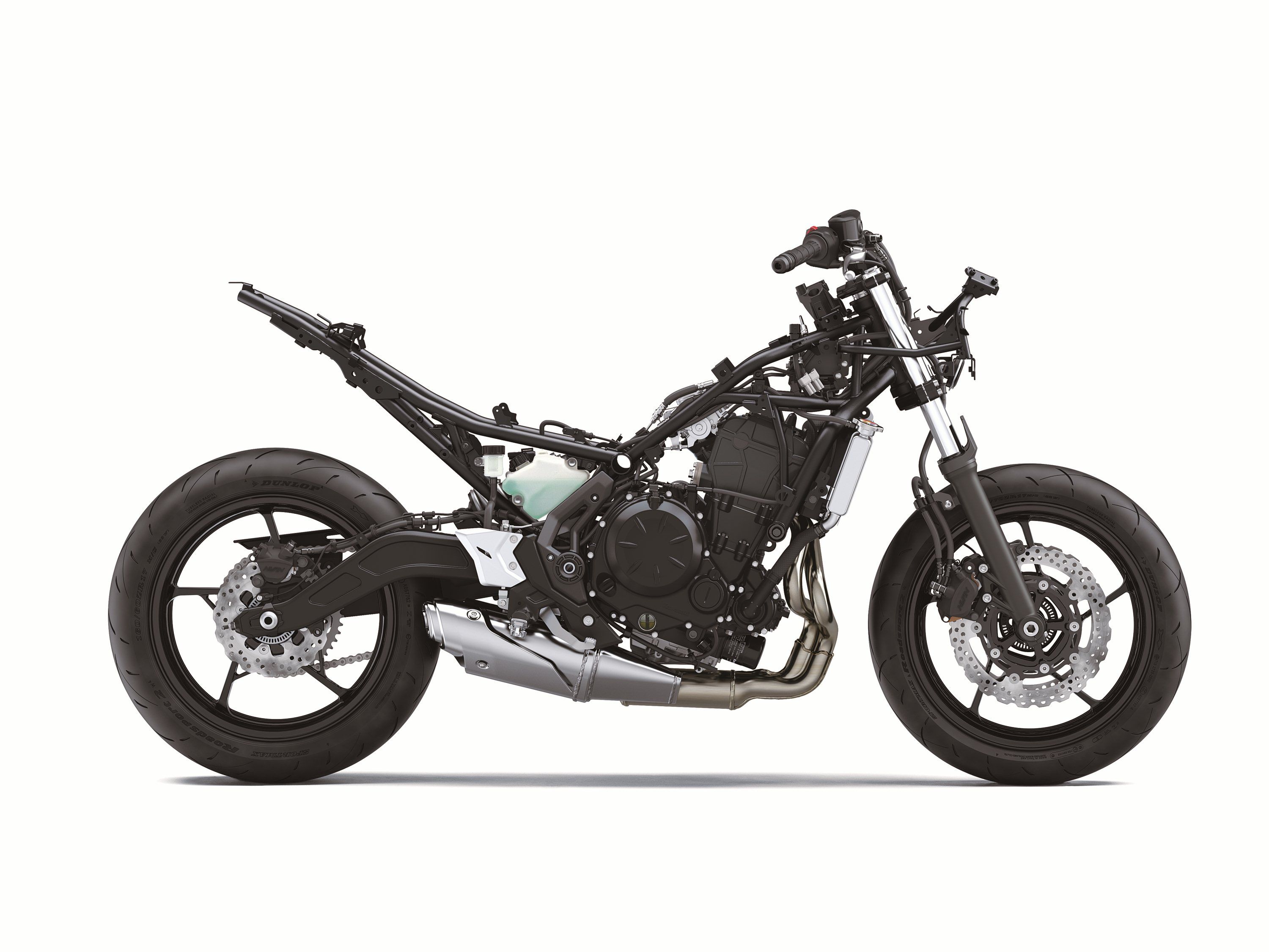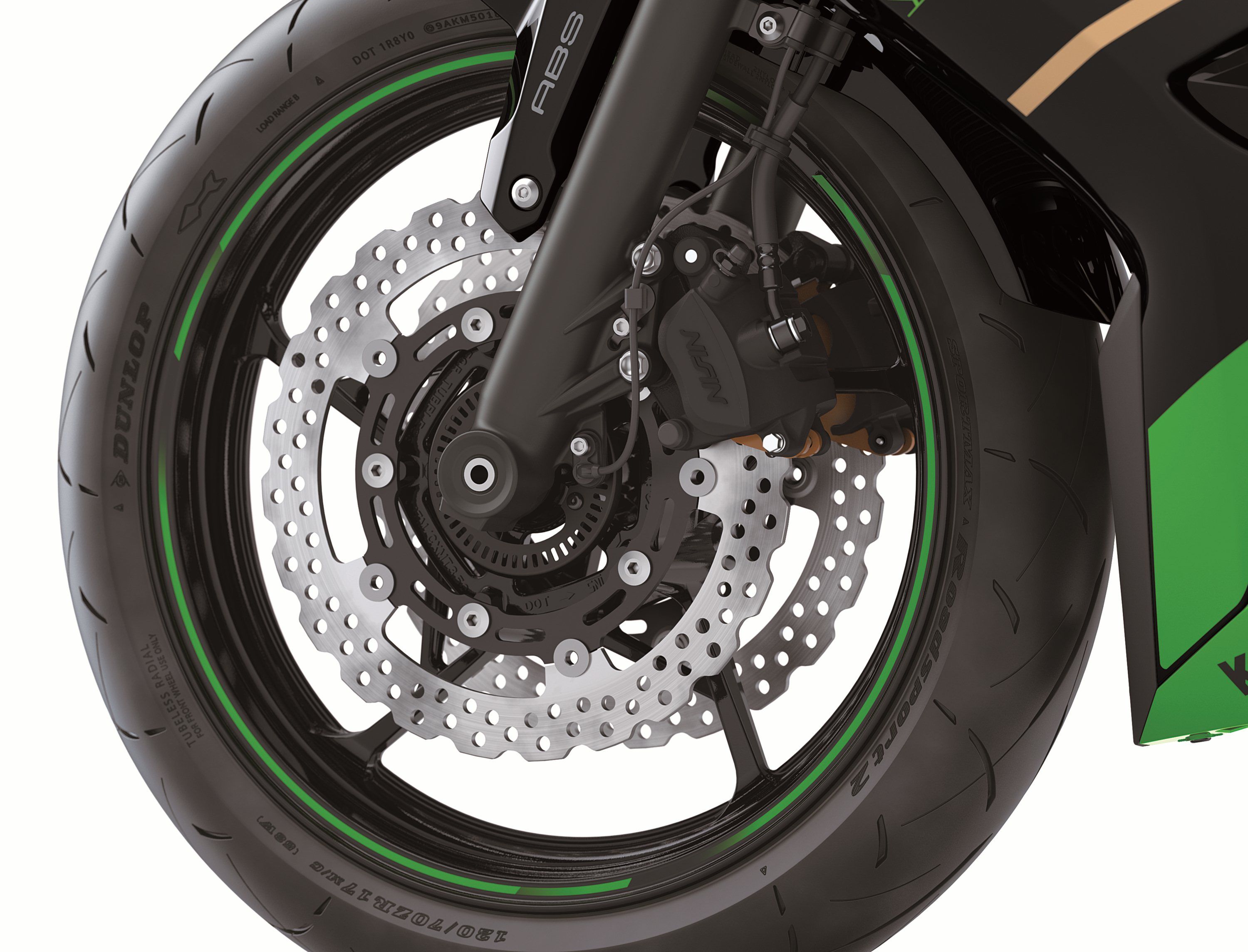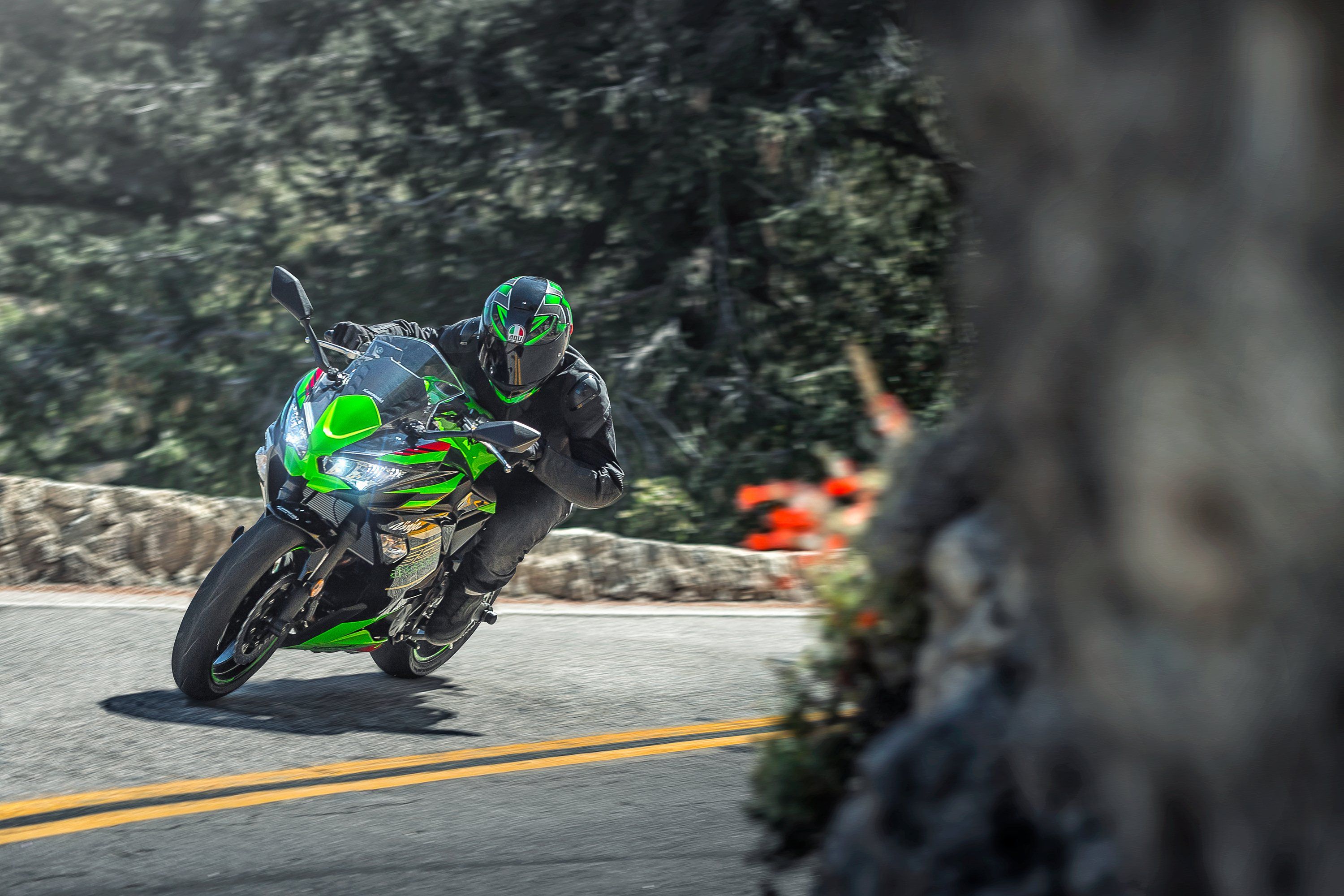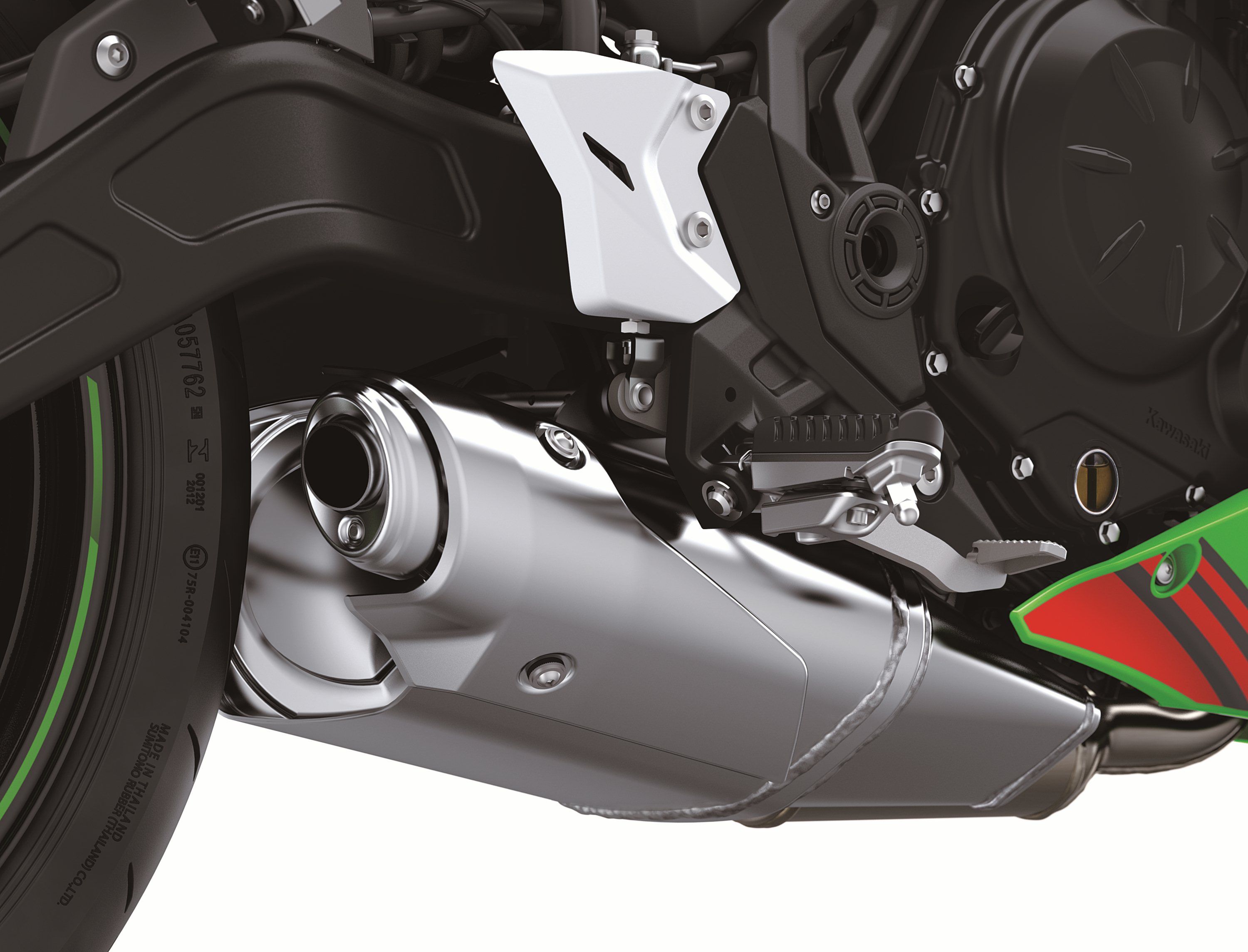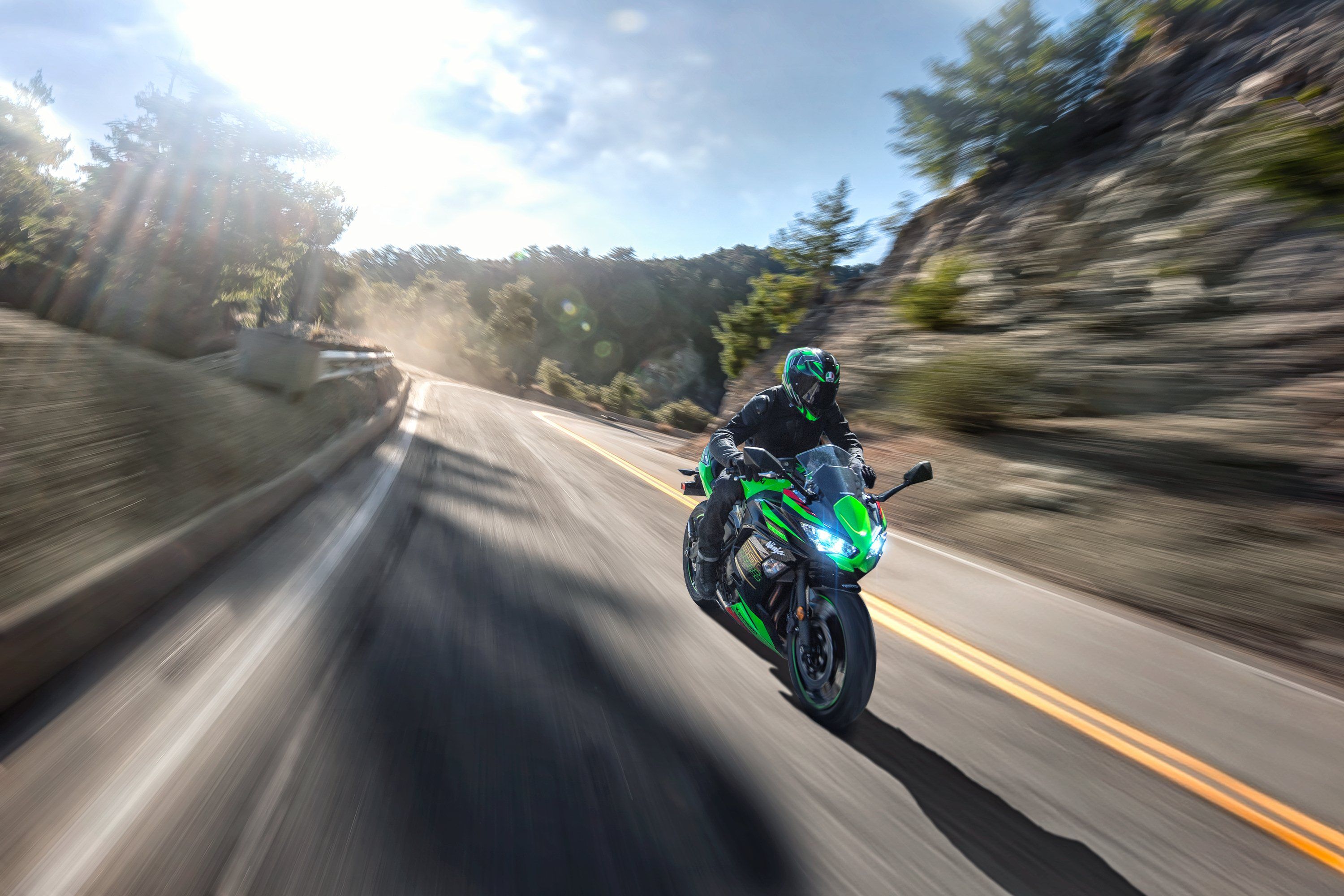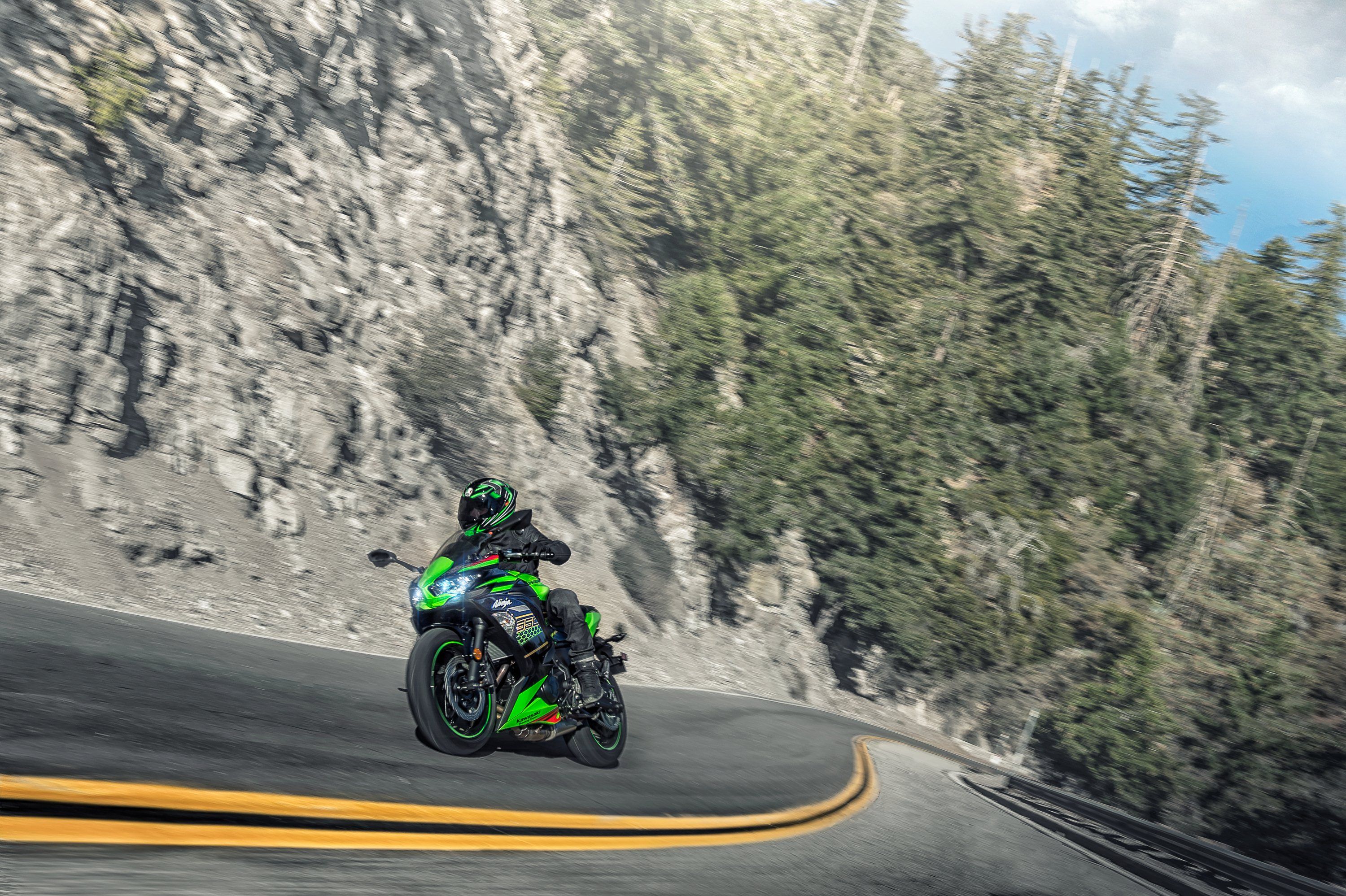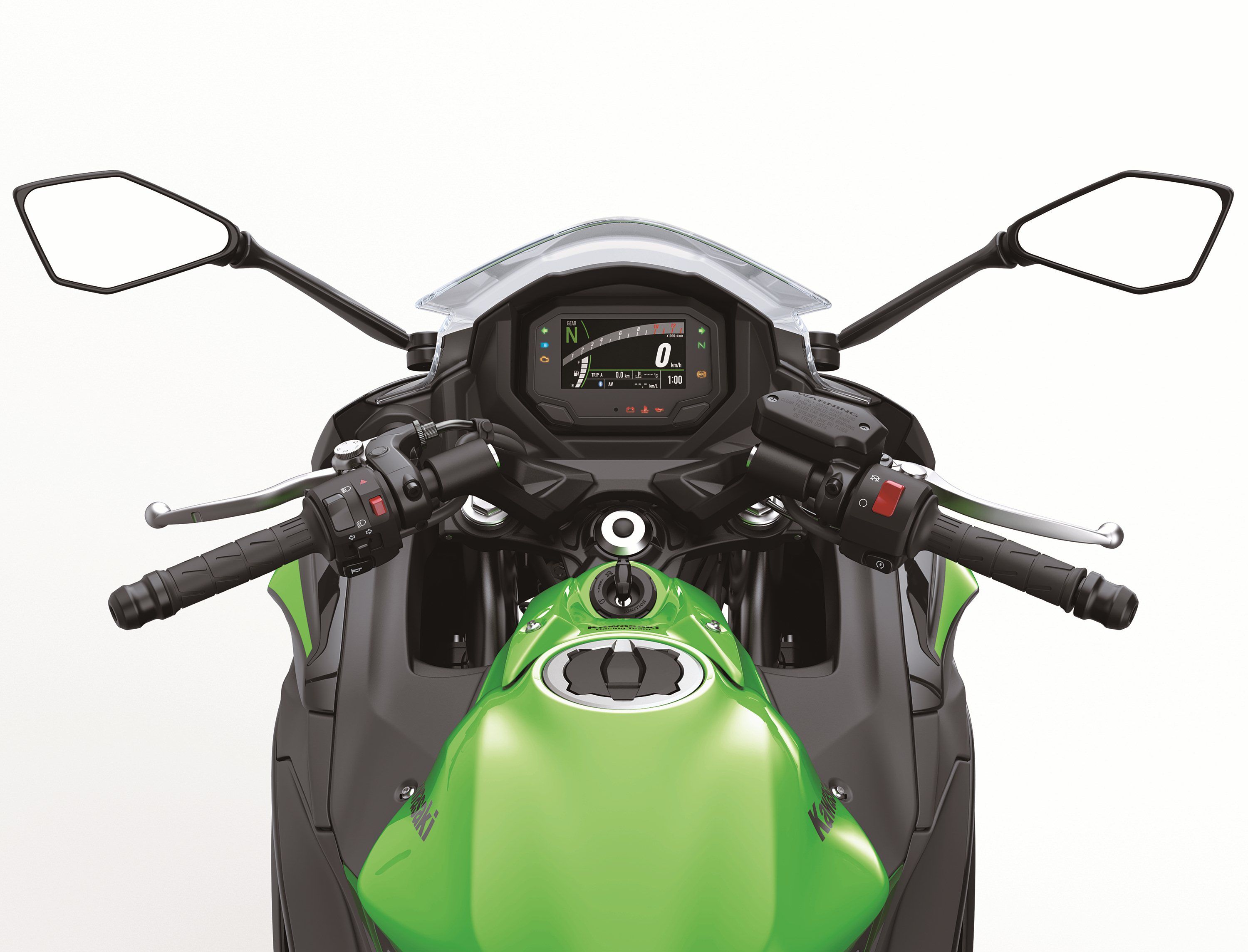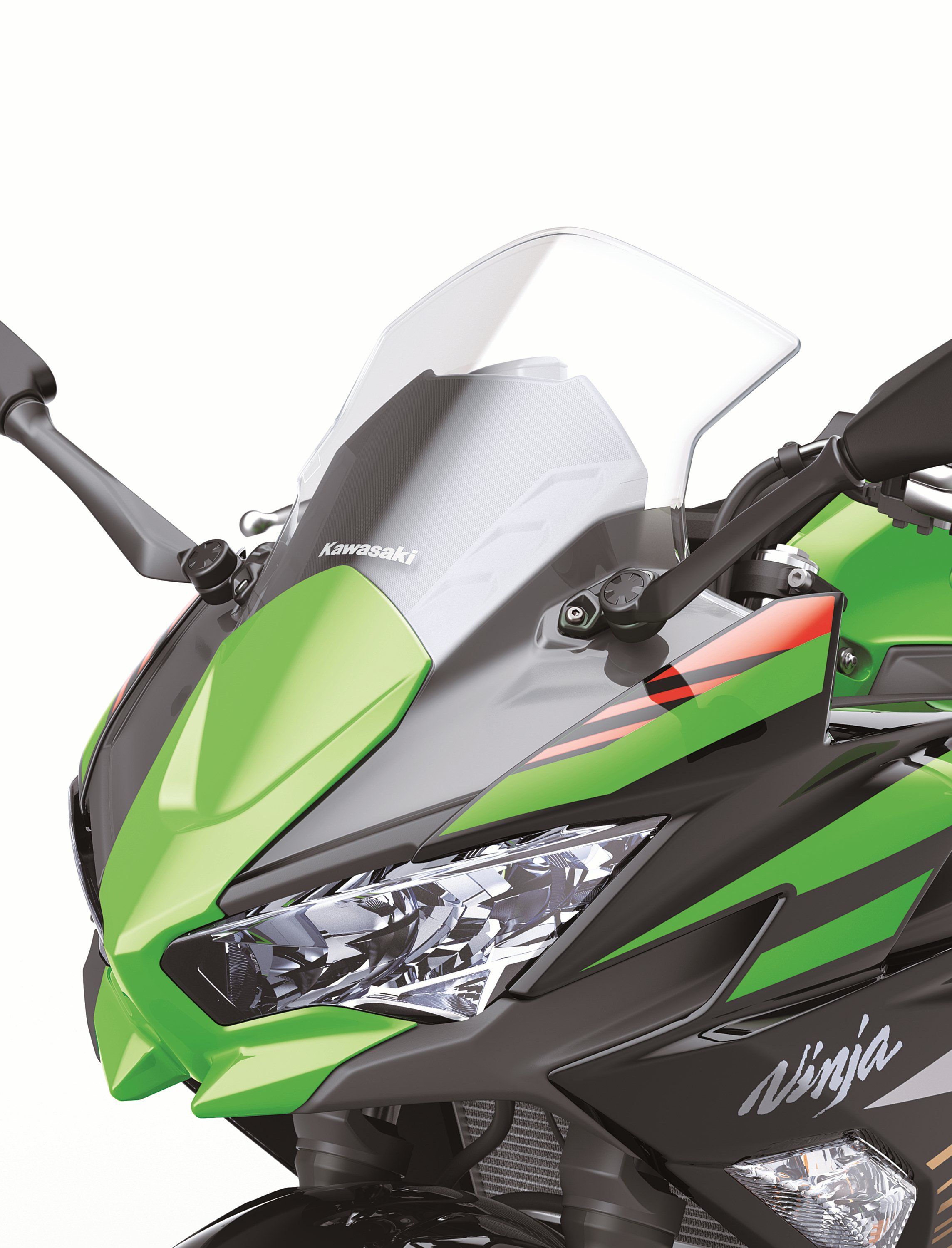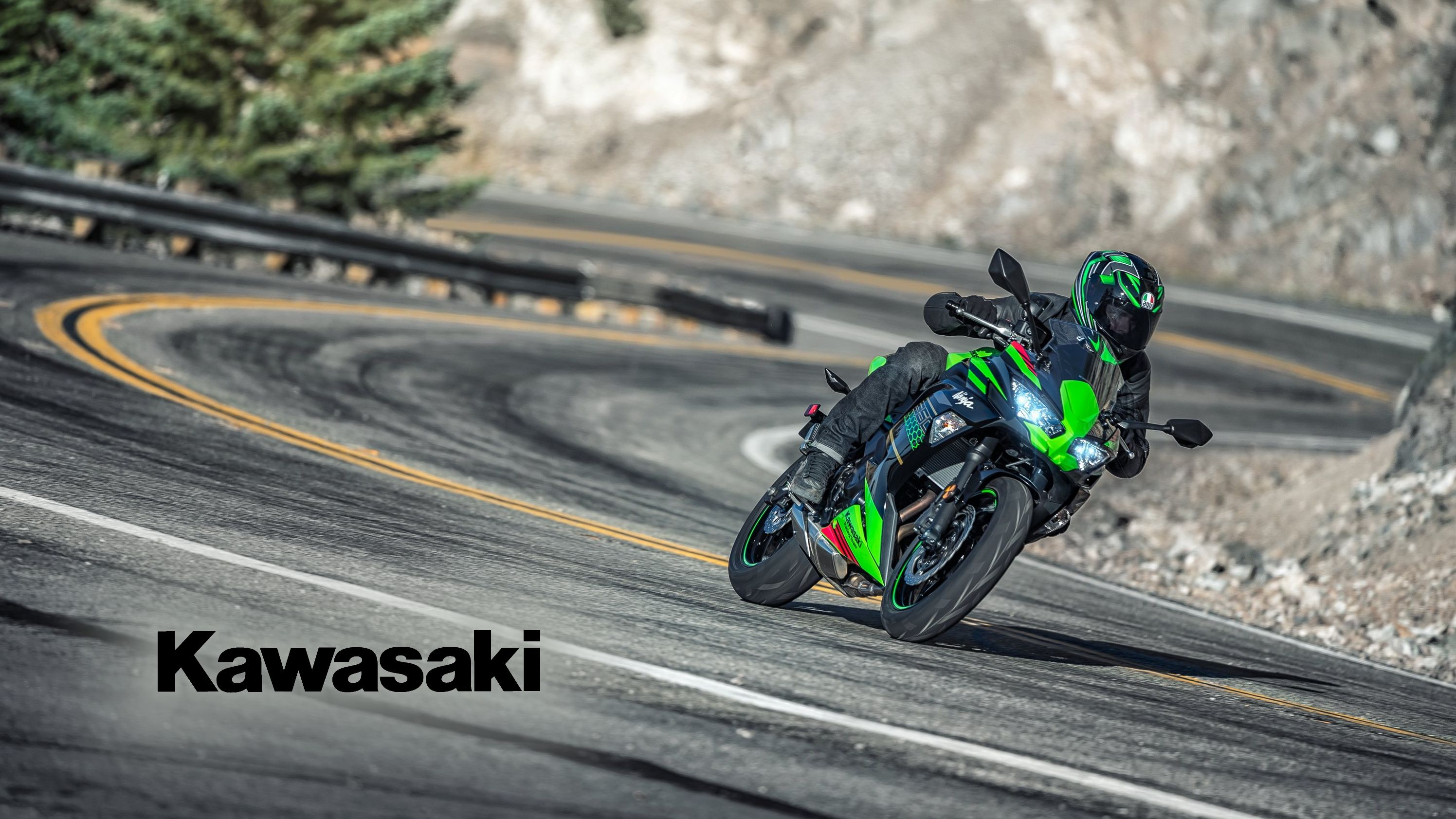Kawasaki gave its Ninja 650 supersport a facelift ahead of MY2020 with aggressive new lines. Safety and visibility were increased through LED technology, and instrumentation moves into the 21st century with a TFT display to deliver the metrics. New tires and new networking technology round out the package along with the engine performance and handling that made the last generation a hit.
Kawasaki Ninja 650 Design
Kawi's Ninja line has always been all about the angular features, and the Ninja 650 takes it to the bank with sharpened angles in the front fairing and cowl scoop . The vented front fender remains almost the same with a cut-down look that also helps to minimize the unsprung weight at the front axle.
Night vision was updated in the form of a pair of LED projectors up front that split the night and ensure you remain visible to daytime traffic. The LED benefits continue into the front turn signals that are recessed in the edge of the cowl scoop well out of harm's way. I think the factory missed an opportunity here. Personally, I'd like to see the blinkers integrated with the mirrors and the current front turn signals turned into cornering lights, but maybe next year. (Wink-nudge, Kawi.)
Prior to the update, the windscreen was held off the fairing for ventilation, but the 2020 model moved to a racing-style bubblescreen to punch a hole in the wind with improved overall penetration, plus the upper fairing is wider and the angles sharper for a more aggressive look. The cowl extends all the way down to form a proper chin fairing and belly pan with ample ventilation to help carry away the waste heat and prevent buildup under the body panels while generating minimal drag. Toward that end, the fairing bolts were eliminated to aid in penetration.
A four-gallon fuel tank sports broad shoulders that wane toward the waist to create the critical knee pocket and allow for extreme cornering body English. The flyline takes a dramatic dive to the deep saddle trough that pulls you down into the machine. The p-pad comes with a tall rise that forms a generous buttstop that'll keep you from driving the thing out from under yourself when you get a little jiggy with it, plus it lofts your passenger for improved visibility.
Yeah, there's a pillion pad, but it's the gunfighter style that suggests a clean, racer-style rear end that rocks thicker urethane padding for passenger comfort. The fold-up passenger footpegs ride on long brackets that are easily struck from the bike if you prefer a true solo-riding experience.
Typical of racebikes in general, the taillight rides in the tip of the tail, and the rear blinker, taglight, and plateholder all mount to the short mudguard that also looks like it can be easily removed as a unit if you actually plan on hitting the track.
Kawasaki Ninja 650 Chassis
High-tensile steel members make up the Trellis frame on the Ninja 650 with minimal bends so the strength is not compromised and it distributes the stress evenly throughout. Typical of the genre, the frame uses the engine as a stressed unit to complete the structure, thereby eliminating some of the forward members to reduce weight while maintaining rigidity. Additionally, the factory used variable-thickness pipes to keep the frame strong where it's needed, and light everywhere else.
The steering geometry points to a very agile nature with 24 degrees of rake and 3.9 inches of trail over a 55.5-inch wheelbase. Seat height is typical at 31.1 inches off the ground, and shorter riders will benefit from the narrow waist when they go to deploy the training wheels at a stop or in the parking lot.
Non-adjustable, 41 mm forks float the front end on 4.9 inches of travel, and out back, a horizontal monoshock runs with the obligatory spring-preload adjuster with 5.1 inches of travel. Cast, 17-inch wheels round out the rolling chassis with Dunlop Sportmax Roadsport 2 hoops in a 120/70 up front opposite a 160/60.
The 425.6-pound wet weight makes for quick flicks and reversals, and the dual 300 mm discs and twin-pot calipers provide plenty of brakeage to haul down the front wheel. In the rear, a 220 mm disc and single-piston anchor take care of business. You get a choice between all-around ABS protection and a slightly lower-priced non-ABS model, so you can take or leave that particular safety net as you please.
|
Frame: |
Trellis, high-tensile steel |
|
Front Suspension / Wheel Travel: |
41mm hydraulic telescopic fork/4.9 in |
|
Rear Suspension / Wheel Travel: |
Horizontal back-link with adjustable spring preload/5.1 in |
|
Rake/Trail: |
24.0/3.9 |
|
Front Tire: |
120/70x17 |
|
Rear Tire: |
160/60x17 |
|
Front Brakes: |
Dual 300 mm petal-type discs and 2-piston calipers and ABS |
|
Rear Brakes: |
Single 220 mm petal-type disc and single-piston caliper and ABS |
Kawasaki Ninja 650 Drivetrain
The Ninja 650 is a fairly essential machine with nothing in the way of electronic fandanglery to complicate the engine controls, so you can forget about traction control or power modes, but you'll be a better rider for it.
The beating heart is a liquid-cooled parallel-twin with a 180-out crankshaft orientation to produce smooth, even power pulses. It rocks an 83 mm bore with a 60 mm stroke for an overall displacement of 649 cc and a compression ratio of 10.8-to-1, so you can expect to feed it top-hook road champagne, or at the very least , use some sort of octane additive to prevent knock/ping/dieseling.
Dual over-head cams time the four-valve head, and induction control falls to a pair of mechanical cable-controlled, 36 mm Keihin throttle bodies that utilize a set of secondary, computer-controlled throttle plates to ensure smooth transitions. There's a catalyst in the exhaust system to burn off any free hydrocarbons that make it through the combustion chamber, and this, along with the EFI system, helps the mill meet emission standards. Power flows through a slipper-style clutch that prevents excessive backtorque from causing the rear wheel to break traction, and a six-speed transmission with a chain-type final drive.
What does all this get you? Well, it generates 48.5 pound-feet of torque at 6,500 rpm, and at the redline in top gear, the overall drive ratio turns in a top speed of 131 mph. That's plenty enough to get yourself in a whole heap of trouble.
|
Engine: |
4-stroke, 2-cylinder, DOHC, water-cooled |
|
Displacement: |
649 cc |
|
Bore x Stroke: |
83.0 mm x 60.0 mm |
|
Compression Ratio: |
10.8:1 |
|
Fuel System: |
DFI® with dual 36 mm Keihin throttle bodies |
|
Ignition: |
TCBI with digital advance |
|
Transmission: |
6-speed |
|
Final Drive: |
Sealed chain |
|
Electronic Rider Aids: |
ABS |
Kawasaki Ninja 650 Pricing
Kawasaki offers the 2022 Ninja 650 and Ninja 650 ABS in a pair of two-tone colors – Metallic Matte Graphensteel Gray or the premium paint Pearl Robotic White/Metallic Carbon Gray – as well as a KRT Edition. No matter which color package you choose, you can expect to pay a base MSRP of $8,299 for the ABS model or $7,899 for the non-ABS and add $200 to the base price for premium paint.
|
Warranty: |
12 Month Limited Warranty (optional Kawasaki Protection Plus™ 12, 24, 36 or 48 months) |
|
Colors: |
|
|
└ 2020: |
Metallic Spark Black, Pearl Blizzard White |
|
└ 2021: |
Metallic Graphite Gray/Metallic Spark Black, Metallic Spark Black/Metallic Imperial Red (ABS only),Metallic Spark Black/Pearl Nightshade Teal (ABS only) |
|
└ 2022: |
Metallic Matte Graphensteel Gray, Pearl Robotic White/Metallic Carbon Gray (KRT Edition: Lime Green/Ebony/Blizzard White) |
|
Price: |
|
|
└ 2020: |
$7,399 (with ABS: $7,799) |
|
└ 2021: |
$7,599 (with ABS: $7,999) |
|
└ 2022: |
$7,899 (with ABS: $8,299) |
Kawasaki Ninja 650 Competitors
The 650 cc supersport bracket is pretty thin at the moment, so for my head-to-head with the Ninja 650, I went for the Honda CBR650F ABS.
Honda CBR650F
Honda keeps to the racer-style design with an aggressive, nose-down tail-up stance meant to bring track-like riding to the public streets. A bubblescreen and engine cowling sets the stage, and so like brothers-from-another-mother, the CBR650F hits all the same design high points as the Ninja 650.
The CBR650F rides on a pair of 41 mm Showa DBV forks that deliver a ride that's superior to what you can expect from vanilla stems like the Ninja uses in spite of a total lack of adjustability, so Honda gains a slight edge in this area. A steel, twin-spar frame provides the main structure for the Honda, and like the Kawi, it's tuned for flexibility where it's needed and rigidity everywhere else to turn in racebike-like handling in the corners for the everyday rider.
Honda opted for a four-banger to drive its entry, but the displacement works out the same with a total of 649 cc across the board and 47 pounds o' grunt at 8,000 rpm, so these two bikes pretty much break even in the torque department.
Kawi picks up its biggest win at the checkout as the Honda fetches almost a grand more for its base CBR650F ABS with a $8,749 sticker. At this price point, that extra grand could be a real dealbreaker for buyers up against a firm budget.
Read our full review of the Honda CBR650F.
He Said
“While there isn't anything really remarkable about the new Ninja 650, it's safe to say that it's a good bike for riders looking for their first upgrade from whatever entry-level machine got them started. The top speed is plenty fast – more than you'll ever need really – and handling is crisp enough to keep you interested. Still, I lament the passing of the Candy Steel Furnace Orange/ Metallic Black Spark paint package that made the MY19 lineup so attractive.”
She Said
My wife and fellow motorcycle writer, Allyn Hinton, says, “Low and mid-range power delivery is smooth and handling is agile, as you would expect from a Ninja. The new styling is unmistakably Ninja and puts the Ninja 650 more in line appearance-wise with the ZX-10R superbike. The new TFT display is easy to read, and of course, everyone is getting onboard with a connectivity app and Kawasaki is no different. The Ninja 650 is a nice mid-displacement sportbike, and while it could be viewed as a stepping stone to a liter bike, lots of folks are landing in this displacement range and staying here.”
Kawasaki Ninja 650 Specifications
|
Engine & Drivetrain: |
|
|
Engine: |
4-stroke, 2-cylinder, DOHC, water-cooled |
|
Displacement: |
649 cc |
|
Bore x Stroke: |
83.0 mm x 60.0 mm |
|
Compression Ratio: |
10.8:1 |
|
Fuel System: |
DFI® with dual 36 mm Keihin throttle bodies |
|
Ignition: |
TCBI with digital advance |
|
Transmission: |
6-speed |
|
Final Drive: |
Sealed chain |
|
Electronic Rider Aids: |
ABS |
|
Chassis: |
|
|
Frame: |
Trellis, high-tensile steel |
|
Front Suspension / Wheel Travel: |
41 mm hydraulic telescopic fork/4.9 in |
|
Rear Suspension / Wheel Travel: |
Horizontal back-link with adjustable spring preload/5.1 in |
|
Rake/Trail: |
24/3.9 |
|
Front Tire: |
120/70x17 |
|
Rear Tire: |
160/60x17 |
|
Front Brakes: |
Dual 300 mm petal-type discs and 2-piston calipers and ABS |
|
Rear Brakes: |
Single 220 mm petal-type disc and single-piston caliper and ABS |
|
Dimensions & Capacities: |
|
|
Overall Length: |
80.9 inches |
|
Overall Width: |
29.1 inches |
|
Overall Height: |
44.7 inches |
|
Ground Clearance: |
5.1 inches |
|
Seat Height: |
31.1 inches |
|
Curb Weight: |
425.6 pounds |
|
Fuel Capacity: |
4.0 gallons |
|
Wheelbase: |
55.5 inches |
|
Top Speed: |
131 mph (est) |
|
Details: |
|
|
Warranty: |
12 Month Limited Warranty (optional Kawasaki Protection Plus™ 12, 24, 36 or 48 months) |
|
Colors: |
|
|
└ 2020: |
Metallic Spark Black, Pearl Blizzard White |
|
└ 2021: |
Metallic Graphite Gray/Metallic Spark Black, Metallic Spark Black/Metallic Imperial Red (ABS only),Metallic Spark Black/Pearl Nightshade Teal (ABS only) |
|
└ 2022: |
Metallic Matte Graphensteel Gray, Pearl Robotic White/Metallic Carbon Gray (KRT Edition: Lime Green/Ebony/Blizzard White) |
|
Price: |
|
|
└ 2020: |
$7,399 (with ABS: $7,799) |
|
└ 2021: |
$7,599 (with ABS: $7,999) |
|
└ 2022: |
$7,899 (with ABS: $8,299) |
Further Reading
Kawasaki
Read more Kawasaki news.

